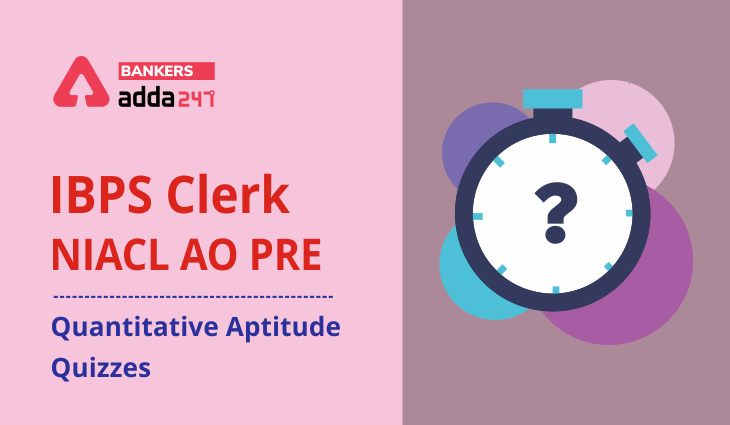Directions (1-5): Paragraph given below gives information of income, expenditure and saving of three friends, read the paragraph carefully and answer the following questions.
Three friends Deepak, Ankit and Shivam spent money in the ratio 2:5:3 and ratio of saving of Deepak to Shivam and income of Ankit to Shivam is 10:7 and 3:2 respectively. Ankit’s saving is 100% more than his expenditure and average saving of Shivam and Ankit is Rs. 8500. (Income = Expenditure + Saving)
Q1. If income and expenditure of Deepak is increases by 10% and 20%, find percentage increase in his saving?
(a) 10% increase
(b) 8% increase
(c) 4% decrease
(d) 1% decrease
(e) None of these.
Q2. Expenditure of Shivam is what percent of his income?
(a) 20%
(b) 60%
(c) 30%
(d) 15%
(e) 12%
Q3. What is the ratio of average saving of Deepak and Ankit to income of Shivam?
(a) 1:2
(b) 2:3
(c) 3:1
(d) 1:3
(e) 1:1
Q4. If Ankit spent 15% of his income on rent and 35% of his expenditure on food and rest he spent on other expenses, find how much he spent on other expenses?
(a) Rs. 1000
(b) Rs. 1750
(c) Rs. 2250
(d) Rs. 1500
(e) Rs. 750
Q5. What is average income of Deepak, Ankit and Shivam?
(a) Rs. 11333.33
(b) Rs. 12333.33
(c) Rs.11366.67
(d) Rs.12366.67
(e) None of these
Directions (6-7): The following questions are accompanied by two statements (I) and (II). You have to determine which statements(s) is/are sufficient/necessary to answer the questions.
(a) Statement (I) alone is sufficient to answer the question but statement (II) alone is not sufficient to answer the question.
(b) Statement (II) alone is sufficient to answer the question but statement (I) alone is not sufficient to answer the question.
(c) Both the statements taken together are necessary to answer the question, but neither of the statements alone is sufficient to answer the question.
(d) Either statement (I) or statement (II) by itself is sufficient to answer the question.
(e) Statements (I) and (II) taken together are not sufficient to answer the question.
Q6. What is the two-digit number?
I. The difference between the two-digit no. and no. after interchanging digits is 18.
II. The unit digit is 2 less than the digit at ten’s place.
Q7. What will be age of Ankit after 8 years?
I. Ratio of present ages of Sanjay and Ankit is 6 : 7. Sanjay is 3 years older than Praveen.
II. Present ages of Ankit and Praveen are in the ratio of 4 : 3.
Directions (8-10): In the following questions, calculate quantity I and quantity II, compare them and answer
(a) If quantity I > quantity II
(b) If quantity I < quantity II
(c) If quantity I ≥ quantity IIs
(d) if quantity I ≤ quantity II
(e) if quantity I = quantity II or no relation can be established
Q8. Quantity I, length of train (in meter): A train crosses a pole in 20 seconds and crosses a bridge of 500 meter in 45 seconds.
Quantity II, length of platform (in meter): A train moving with speed of 72 kmph crosses a man who moving in opposite direction of train at speed of 3 kmph in 19.2 seconds and crosses a platform in 35 seconds.
Q9.
Quantity I, x:20x²-51x+28=0
Quantity II, y:15y²-44y+21=0
Q10. Quantity I, profit share of B: A and B entered into a business with an investment of Rs 20000 and Rs 24000 respectively. After 4 months, A invested Rs 5000 more while B withdraws Rs 5000. At the end of the year they earned a profit of Rs 19800.
Quantity II: Rs 9500
Directions (11-15): Find the wrong no. in the gives series.
Q11. 3, 5, 14, 48, 200, 1020, 6072
(a) 1020
(b) 200
(c) 6072
(d) 5
(e) 48
Q12. 48, 84, 156, 300, 590, 1164, 2316
(a) 300
(b) 590
(c) 48
(d) 156
(e) 2316
Q13. –18, –8, 12, 36, 70, 112, 162
(a) –18
(b) 36
(c) 70
(d) 162
(e) 12
Q14. 2, 6, 12, 24, 30, 42, 56.
(a) 6
(b) 12
(c) 24
(d) 30
(e) 56
Q15. 100, 92, 65, 0, –124, –340, –683
(a) 0
(b) 100
(c) –340
(d) –683
(e) 92
Solutions

Click Here to Register for Bank Exams 2021 Preparation Material





 GA Capsule for SBI Clerk Mains 2025, Dow...
GA Capsule for SBI Clerk Mains 2025, Dow...
 The Hindu Review October 2022: Download ...
The Hindu Review October 2022: Download ...
 UCO Bank LBO Result 2025 Out, Direct Lin...
UCO Bank LBO Result 2025 Out, Direct Lin...





